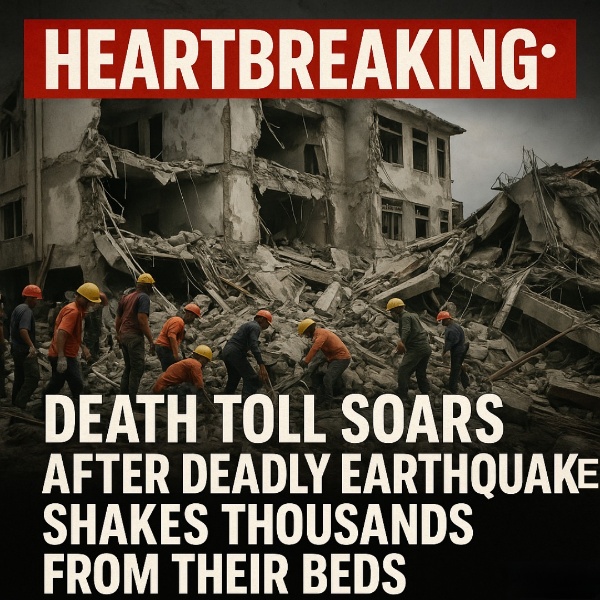The Philippines has been thrown into a state of shock and profound mourning after a devastating earthquake struck the central island of Cebu late Tuesday night. The 6.9-magnitude tremor, described by seismologists as shallow and exceptionally destructive, hit just before 10 p.m., shaking homes violently and forcing terrified families to flee into the dark streets. According to the United States Geological Survey (USGS), the quake’s epicenter was near Bogo City, home to around 90,000 residents, but its effects spread across much of the island.
The damage was immediate and catastrophic. In Cebu City alone, authorities confirmed at least 31 deaths, while surrounding towns and provinces reported dozens more. Entire neighborhoods were reduced to rubble, schools collapsed beneath their concrete roofs, and small shops crumbled as if made of paper. Officials warned the death toll would likely rise as rescue teams continued searching for survivors and recovering victims.
Eyewitnesses recounted sheer terror as the ground shook violently. “The ground shook like it had a mind of its own,” said Maricel Santos, a 42-year-old mother of three. She ran barefoot with her children as their house split apart behind them. “If we had hesitated, we would have been buried alive. The walls fell within seconds after we escaped.”
Others described seeing power lines thrash violently, sending sparks flying as transformers exploded. Entire districts plunged into darkness, illuminated only by flashlights, car headlights, and flickering candles. The chaos left residents frightened and disoriented, unsure where to seek safety in the midst of crumbling structures.
The aftermath was compounded by power outages and communication failures. Cell towers collapsed, leaving towns isolated and residents unable to contact loved ones. Damaged highways hampered relief efforts, forcing authorities to deploy helicopters and boats to reach remote areas. In rural villages, survivors clawed through rubble with bare hands, calling out for neighbors and relatives, their voices cutting through the eerie silence.
Emergency services mobilized immediately, though resources were stretched thin. Thousands of soldiers, firefighters, volunteers, and paramedics raced against time. Tents were erected outside hospitals to handle the influx of injured, and makeshift triage centers were set up in open fields. Doctors worked under floodlights powered by generators, stabilizing patients before transport.
Heartbreaking stories emerged, especially involving children. In northern Cebu, an elementary school collapsed, trapping students inside. Teachers and volunteers rescued some, but several remained missing. Churches, once sanctuaries, became sites of tragedy as their stone walls crumbled, leaving families praying desperately for loved ones.
Survivors faced new dangers even after escaping. Water systems were destroyed, food was scarce, and thousands gathered in temporary shelters, bracing for aftershocks. Many clutched remnants of their homes—clothes, photos, or treasured items—seeking comfort amid the chaos. Fear of returning indoors lingered, with families uncertain if they would ever feel safe again.
The quake reignited debates about infrastructure and preparedness. Situated on the Pacific “Ring of Fire,” the Philippines regularly experiences earthquakes and volcanic activity. Experts warned that many buildings, especially in rural areas, are ill-equipped to withstand strong tremors. Newer high-rises in Cebu City survived, but countless older structures collapsed instantly, exposing critical weaknesses in construction and safety standards.
International aid agencies responded swiftly. The Red Cross dispatched teams with emergency shelter, clean water, and medical supplies. Neighboring countries offered specialized rescue teams and financial support. The United Nations expressed condolences and pledged support, recognizing the challenge of assessing the full scale of destruction. Amid the devastation, the resilience of the Filipino people shone through, with neighbors helping neighbors and communities uniting to confront immense tragedy.
The Philippines faced a sudden and tragic disaster when a 6.9-magnitude earthquake struck Cebu late Tuesday night, catching residents off guard and sending families fleeing into the streets in terror.
The destruction was immediate: homes, schools, and small businesses collapsed, leaving dozens dead and hundreds injured, while officials warned that the death toll would almost certainly rise in the days to come.
Eyewitnesses described chaos and fear as buildings shook and power lines sparked violently, plunging entire districts into darkness illuminated only by flashlights and car headlights.
Communication and transportation systems were crippled, leaving many towns isolated and forcing rescue teams to rely on helicopters and boats to reach the hardest-hit areas.
Thousands of emergency responders, volunteers, and medical personnel mobilized quickly, setting up temporary shelters and triage centers to treat the injured amid overwhelming devastation.
Heartbreaking stories emerged from collapsed schools and churches, with children trapped inside and families clinging to hope as they waited for signs of survival.
Survivors faced ongoing challenges, including lack of clean water, food shortages, and the constant fear of aftershocks, leading many to remain in makeshift outdoor shelters.
The earthquake reignited debates about infrastructure safety, highlighting the vulnerability of older buildings and the urgent need for stricter construction standards in a country prone to seismic activity.
International aid agencies and neighboring countries quickly responded, sending rescue teams, supplies, and financial support, while the United Nations pledged ongoing assistance.
Amid the destruction, the resilience and solidarity of the Filipino people stood out, with communities uniting to save lives, rebuild, and support one another through unimaginable loss and trauma.
